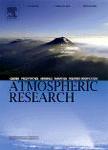版权所有:内蒙古大学图书馆 技术提供:维普资讯• 智图
内蒙古自治区呼和浩特市赛罕区大学西街235号 邮编: 010021

作者机构:Nanjing Univ Informat Sci & Technol Key Lab Meteorol Disaster Collaborat Innovat Ctr Forecast & Evaluat Meteorol Minist Educ KLMEJoint Int Res Lab Climate Environ Nanjing Peoples R China Nanjing Joint Inst Atmospher Sci Key Lab Transportat Meteorol China Meteorol Adm Nanjing Peoples R China Wuxi Univ Sch Atmosphere & Remote Sensing Wuxi Peoples R China
出 版 物:《ATMOSPHERIC RESEARCH》 (Atmos. Res.)
年 卷 期:2025年第315卷
核心收录:
学科分类:07[理学] 070601[理学-气象学] 0706[理学-大气科学]
基 金:National Natural Science Foundation of China [42275164, 42205162, 42105030] Postgraduate Research and Practice innovation Program of Jiangsu Province [KYCX23_1304] Basic Research Fund of CAMS [2022Y027] Joint Research Project for Meteorological Capacity Improvement [24NLTSZ010]
主 题:Subseasonal precipitation forecasts Predictability analysis Machine learning Dynamical-statistical model
摘 要:Rainfall in southern China (SC) reaches its annual peak in early summer (May-June), which is often accompanied by the occurrence of rainstorm and flooding disasters. Reliable subseasonal precipitation forecasts play important roles in disaster prevention and mitigation. In this study, the four leading predictable patterns (accounts for 63.24 % of the total variance) of weekly precipitation anomalies (WPA) over Southern China (SC) during early summer and the corresponding signal sources in European Centre for Medium-Range Weather Forecasts (ECMWF) are analyzed. The first and second predictable patterns present uniform and meridional dipole pattern over SC, respectively, while the third and fourth predictable patterns feature with the tripole patterns. Further analysis indicates that the low-level anomalous anticyclone centered over the tropical western Pacific and the lower-level subtropical western North Pacific anomalous anticyclone are the key predictability sources for the first and second predictable patterns, respectively. Although ECMWF shows limited forecast skills in predicting the four leading predictable patterns after 2-week lead time, it can capture the associated large-scale circulation features to a large extent even up to 4-week lead time. Against this backdrop, we develop a dynamical-statistical model (DSM) using random forest to reconstruct these predictable patterns of WPA based on the associated largescale features in ECMWF. The DSM can extend the forecast skills of WPA up to 4-week lead time over the majority area of SC and increase regional average TCC by similar to 0.1 compared to the ensemble mean forecast from ECMWF for 3-4-week lead times. Further analysis indicates that the enhanced TCCs of DSM compared with ECMWF can be largely attributed to the enhancement in predicting the second predictable pattern. The proposed DSM is very promising in subseasonal precipitation forecasts and can also be applied to the routine forecast of other atmosphe